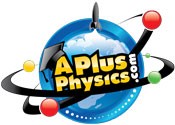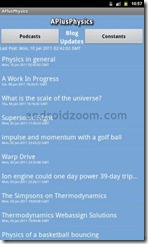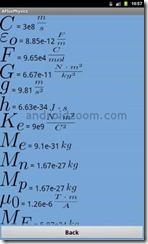
Tag Archives: APlusPhysics
Regents Test Prep: Get Your Review Books!
It’s that time of year — the Regents Physics Exam is rapidly approaching. Now is a great time to pick up a copy of APlusPhysics: Your Guide to Regents Physics Essentials. You can find it in popular bookstores as well as online at Amazon.com.
“Very well written… simple, clear, engaging and accessible. You hit a grand slam with this review book.” — Anthony, NY Regents Physics Teacher.
“Does a great job giving students what they need to know. The value provided is amazing.” — Tom, NY Regents Physics Teacher.
“This was tremendous preparation for my physics test. I love the detailed problem solutions.” — Jenny, NY Regents Physics Student.
“Regents Physics Essentials has all the information you could ever need and is much easier to understand than many other textbooks… it is an excellent review tool and is truly written for students.” — Cat, NY Regents Physics Student.
“This book felt like I had a teacher/professor talking right next to me with slight humor thrown in… it lists great real world examples for every aspect of physics.” — Jake, Physics Enthusiast.
Now available for electronic devices such as iTouch, iPhone, iPad, Android, and Blackberry through the Kindle store.
Kinematics & Gravity Lab
APlusPhysics Regents Course Tutorials Completed!
Whew! It’s been a long and challenging project, but I am thrilled to announce that the APlusPhysics.com Regents Physics course tutorial has been completed (well, at least the first revision). I’ve been done with the tutorial less than 20 minutes, and already I’m making notes on additions, modifications, and enhancements, but I think it’s worth taking a moment to step back and look at everything that’s been accomplished.
A year ago I had never created a web page, and didn’t know the difference between HTML and ELMO. But, with a vision to create a resource specific to the needs of the students I see every day, and with the support of friends and family, I started picking up books, reading web articles, and making many, many designs on paper to script out what I wanted to build.
As of this morning, with the upload of a question bank of more than 500 Regents Physics questions from past years, I’m amazed at how much has been created. The APlusPhysics Regents Tutorials include objectives, explanations, sample problems, FLASH animations, integrated quizzes, videos… just about everything you could ask for in an online resource tailored to a specific course.
So what comes next? I’d like to continue my work to pre-record video lessons of all the major topics in the Regents Physics course, with the ultimate goal of spending in-class time working on hands-on lab activities, as well as supporting students individually and in small groups, and minimizing the less-effective entire-class-instruction time. Second, several students have inquired as to whether I might take the course content material on APlusPhysics and expand it into a written mini-book / synopsis for the Regents Physics course. Though initially hesitant, the more I think about it, the more I find value in creation of the written “APlusPhysics’s Guide to Regents Physics.” And oh, by the way, did I mention the list of website enhancements I’ve already started on?
The question, then, is where to start. As much as I try to deny it, I know I’ll be working on website revisions by tonight, in tandem with my next project. So which to tackle next, the video mini-lessons, or the printed guidebook? Or both? Would love to hear your feedback and thoughts!
And, as with any endeavor of such scale, allow me to again thank all my supporters, students, colleagues, family members and contributors. This is a huge milestone for APlusPhysics and the culmination of hundreds of hours of frustration and effort, which has already paid for itself in personal learning and confidence. I’ve come out all the better for it, and I hope this resource helps others say the same.
APlusPhysics XtraNormal Promo
Mid-Term Exam Results 2010-2011
Mid-Term results have been compiled and published. In general, scores are right in line with performance within the last few years. The exam itself was styled after the Regents Exam which is given at the end of the school year, and included topics from all aspects of Newtonian Mechanics (roughly half of the Regents Exam). This included 46 multiple choice questions, and 25 open-ended, or “free response,” type questions. Students were given 180 minutes to complete the exam, as well as a formula sheet (Regents Physics Reference Table), and a ruler. Students were permitted the use of a scientific calculator.
Summary Data
Summary data from this year’s exam, along with the previous two years of data, are shown at right.  Average score on the exam, with a fairly generous curve, was 76%, compared to 73% in 2010 and 74% in 2009. Median score was 78%, two points higher than last year’s exam, and right in line with 2009 scores. Percentage of students scoring above 85%, considered “Mastery Level” by Regents Physics standards, was 25%, slightly lower than in 2010 and 2009, but passing percentage was 83%, several points higher than in past years. Even more promising is a glance at a histogram
Average score on the exam, with a fairly generous curve, was 76%, compared to 73% in 2010 and 74% in 2009. Median score was 78%, two points higher than last year’s exam, and right in line with 2009 scores. Percentage of students scoring above 85%, considered “Mastery Level” by Regents Physics standards, was 25%, slightly lower than in 2010 and 2009, but passing percentage was 83%, several points higher than in past years. Even more promising is a glance at a histogram  breaking down student scores further. This data indicates that we have many students in the 80-85% range. Past history has shown me that it is quite possible for students to improve their scores from 10-15% points between now and the actual Regents Exam in June with focused effort, study, and motivation. This indicates the potential for outstanding standardized exam performance in June if students buckle down and focus their efforts. Unfortunately, the Physics Regents Exam is usually one of the last tests offered (sometimes even after official graduation), so obtaining and maintaining student focus at this point of the year can be a challenge.
breaking down student scores further. This data indicates that we have many students in the 80-85% range. Past history has shown me that it is quite possible for students to improve their scores from 10-15% points between now and the actual Regents Exam in June with focused effort, study, and motivation. This indicates the potential for outstanding standardized exam performance in June if students buckle down and focus their efforts. Unfortunately, the Physics Regents Exam is usually one of the last tests offered (sometimes even after official graduation), so obtaining and maintaining student focus at this point of the year can be a challenge.
Cluster Data
Breaking down exam performance by topic, we observe students demonstrating a very strong understanding of Newton’s Laws of Motion, Hooke’s Law (springs), and Work and Energy. These have been focus areas during the year, although there is room for further improvement in understanding Newton’s 2nd Law as well as momentum and impulse.
Cluster data indicates weaknesses in Newton’s Law of Universal Gravitation, although a deeper look at the questions and errors themselves indicates that most of the confusion here is a result of mathematical errors rather than conceptual misunderstandings. This is being re-emphasized as we work through Coulomb’s Law / Electrical Force problems, which utilize almost the exact same mathematical model. Other areas for improvement include 2-D Kinematics (projectile motion), a perennial challenge, and utilizing and understanding the metric system, a topic that has been emphasized and will continue to be reviewed throughout the year. Performance on momentum problems was, unsurprisingly, problematic. This relates directly to a “class as a whole” issue with independent practice and motivation throughout that unit, and will be our top priority for review in mid-June.
Conclusions
Student performance is in line with, if not slightly above, expectations for this point in the year. With a focused effort, students can fairly routinely increase their scores 10 to 15 percentage points by June. For struggling students, a variety of remediation protocols are being put in place, including the entire course content and sample quizzes available on the web, tailored directly to this course’s requirements (APlusPhysics.com), video lectures on topics corresponding directly to our textbook (Hippocampus), and even review sessions which can be viewed from any computer supporting iTunes (Windows, Mac, Linux, etc.) as well as iPods, iPhones, Blackberries, Android devices, etc. All of these resources are available both in the classroom as well as the school library for those who don’t have ready access to these resources outside of school.
Data has also been broken down to the same level for individual students, and will be utilized to develop both entire-class and individual review plans to allow students to focus on areas that will provide the biggest “bang for the buck” in their studies.
APlusPhysics Android App Released!
The first version of the APlusPhysics application for Google’s Android OS has been released and is available for free download from AndroidZoom.com.
APlusPhysics.com is a website dedicated to providing users with review materials and real-life applications of physics. The complexity of topics ranges from NYS Regents level physics to AP-C Physics (Mechanics and E&M). This app displays all recent blog posts and podcasts published on APlusPhysics.com. The user can read blog posts and stream or download podcasts. Downloaded podcasts must be stored in the SD card present in the phone.
In addition, an easy-to-read list of constants can be viewed that includes all constants used in Regents and AP-C Physics. Clicking a constant displays the name of that constant.
I am extremely open to feature requests. Let me know!
Package: com.kking.apphysics
Screenshots of the application in action have been released:
Special thanks to developer Kevin King for his terrific work on this project!






